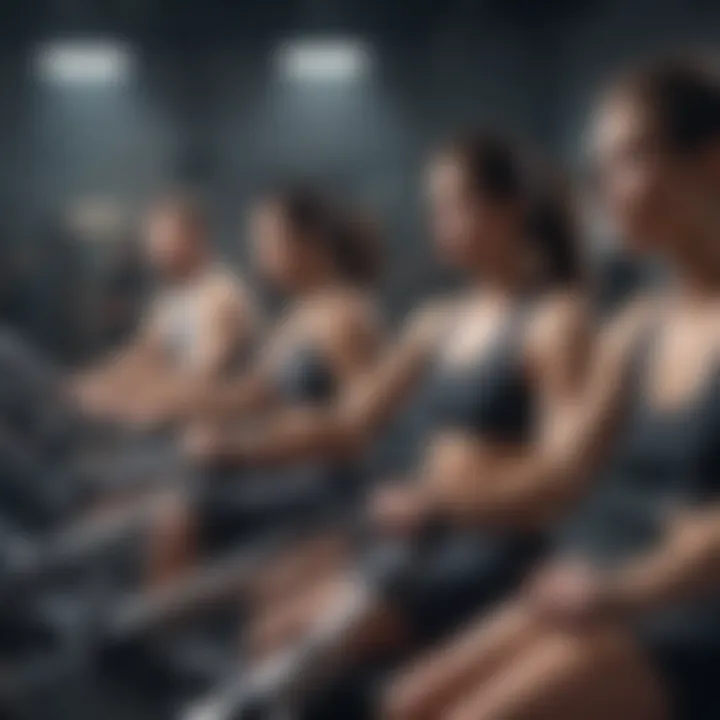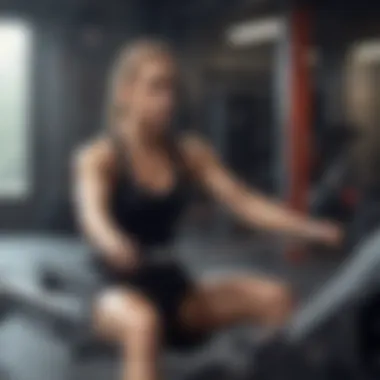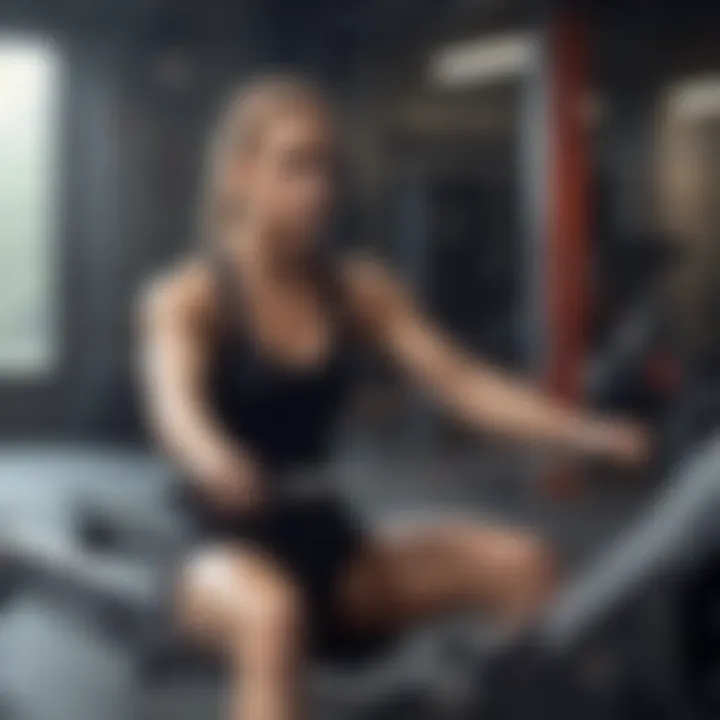The Comprehensive Benefits of Rowing Machines in Fitness


Intro
Rowing machines, often overlooked in the realm of fitness equipment, prove to be a powerful tool for enhancing physical and mental well-being. Their unique mechanism of engaging multiple muscle groups allows for a low-impact yet effective cardio workout. With the increasing popularity of fitness trends, understanding how these machines affect overall health becomes crucial. This article delves into the multifaceted benefits of rowing machines, exploring their physiological impacts and the advancements they offer for varied fitness levels.
Key Benefits
Rowing offers an array of benefits, making it a valuable addition to any fitness regime. It is essential for individuals to comprehend these benefits thoroughly to harness the potential of rowing effectively.
Physical Health Benefits
Engaging with a rowing machine provides a comprehensive workout. The physical benefits include:
- Cardiovascular Improvement: Regular use enhances cardiovascular health, boosting heart efficiency and endurance.
- Muscle Strengthening: Rowing targets key muscle groups in the legs, core, and arms, promoting muscle growth and strength.
- Calorie Burning: Rowing can burn a significant number of calories, aiding in weight management.
- Joint Safety: The low-impact nature of rowing means it is gentle on joints, making workouts accessible for people with joint concerns.
Through consistent engagement, the body becomes more resilient and adaptable, warding off chronic diseases. Fitness professionals often recommend rowing to build a strong foundation in fitness regimes.
Mental Well-being Enhancements
The psychological aspects of rowing are often underrated but play an important role in overall fitness. Engaging in rowing can lead to:
- Stress Reduction: The rhythmic motion promotes relaxation, releasing endorphins that alleviate stress and anxiety.
- Enhanced Focus: Rowing requires coordination and concentration, which can improve mental acuity.
- Mood Elevation: Regular workouts contribute to a positive mood, addressing symptoms of depression.
As individuals engage in consistent rowing, a stronger mind-body connection develops, benefiting mental health in profound ways.
"Physical exercise not only strengthens muscles but also fortifies the mind against daily stressors."
Practical Tips
Incorporating rowing into a fitness routine requires strategic planning. Here are practical tips for maximizing benefits.
Effective Meal Planning
Proper nutrition is vital to complement your rowing workouts. Consider the following:
- Balanced Diet: Focus on a diet rich in lean proteins, whole grains, and fresh fruits and vegetables to support energy needs.
- Hydration: Keep hydrated before, during, and after workouts to optimize performance and recovery.
- Timing of Meals: Eating a small meal or snack an hour before rowing can enhance energy levels and workout effectiveness.
Quick and Efficient Workouts
Making time for rowing can be a challenge. Here are strategies for efficient workouts:
- Interval Training: Incorporate high-intensity intervals to maximize calorie burn in a shorter time frame.
- Short Sessions: Aim for at least 20 to 30 minutes of focused rowing, which can be easily accommodated in a busy schedule.
- Track Progress: Utilize fitness trackers or apps to monitor improvements over time, ensuring motivation stays high.
By understanding the impact of rowing machines and implementing strategic techniques, fitness enthusiasts can fully embrace its transformative potential. This synthesis emphasizes the necessity of rowing as a critical element in a balanced fitness journey.
Preamble to Rowing Machines
Rowing machines have become popular fitness tools, largely due to their multifarious benefits for physical conditioning. They offer a unique way to blend cardiovascular training with strength exercises. Understanding rowing machines is crucial for anyone looking to improve their fitness. This section dives into the basics of rowing and differentiates the various types available.
Understanding the Basics of Rowing
Rowing mimics the movement of traditional rowing done on water, involving a sequence of pushing and pulling that engages multiple muscle groups. It primarily targets the legs, back, and arms, while also enhancing core stability. Learning these basic mechanics is essential as they set the foundation for effective use of the machine. A proper rowing stroke involves four key phases: the catch, drive, finish, and recovery. Each phase plays an important role in optimizing performance and minimizing injury risk.
Types of Rowing Machines
Different types of rowing machines exist, each with its own unique features and benefits. Understanding these variations helps users select the most suitable equipment for their particular needs.
Air Rowers
Air rowers utilize air resistance, providing a smooth rowing experience that mirrors real-life rowing conditions. They are well-known for their adaptability, as the resistance increases in tandem with the user's effort. This means, the harder you pull, the more resistance you encounter. This characteristic makes air rowers a beneficial choice for serious fitness enthusiasts and competitive rowers, as they allow for intense and variable training.


Water Rowers
Water rowers use water as resistance, providing a unique and natural rowing experience. The sound of water adds to the overall feel, making workouts more immersive. They generate resistance based on the user’s rowing speed. Therefore, faster strokes generate more resistance. This adaptability makes water rowers a popular choice among those who prefer a quieter workout, although they can be heavier and take up more space than their counterparts.
Magnetic Rowers
Magnetic rowers operate using magnets to create resistance, which results in a silent and smooth rowing motion. These machines typically offer adjustable resistance levels, making them highly user-friendly. They appeal to home users who prioritize noise reduction and space-saving designs. Despite their advantages, magnetic rowers may not provide the same level of natural feel as air or water rowers, which can be a drawback for some.
Hydraulic Rowers
Hydraulic rowers employ hydraulic cylinders to create resistance. They are often more compact and affordable, which makes them accessible for people at various fitness levels. They provide a straightforward way to work on both upper and lower body strength. However, hydraulic rowers might not allow users to fully replicate the rowing motion experienced in water, which can affect the overall rowing experience.
"Selecting the right rowing machine can significantly influence your workout's effectiveness. Understanding the distinct mechanics and characteristics of each type will lead to better training outcomes."
Physiological Benefits of Rowing
Understanding the physiological benefits of rowing is crucial for anyone looking to enhance their fitness journey. Rowing machines offer a complete workout that engages various muscle groups. They not only boost physical endurance but also contribute significantly to overall health. The discussion herein focuses on cardiovascular health, muscle engagement, and caloric burn. Each element plays a distinct role in fitness, which makes rowing machines a powerful tool in any training regimen.
Cardiovascular Excellence
Rowing machines provide an exceptional cardiovascular workout. This form of exercise effectively elevates the heart rate, leading to improved heart health. Consistent use of rowing machines can enhance aerobic capacity. Rowers experience an increase in stroke volume, allowing for greater oxygen delivery to muscles. This evolution benefits not just athletes but also individuals seeking a more active lifestyle. Rowing can be a low-impact alternative to running, reducing strain on joints while maximizing cardiovascular benefits.
Muscle Engagement Overview
Upper Body Involvement
The upper body's participation in rowing is significant. Users primarily engage their arms, shoulders, and back. The pulling motion helps build muscle strength in these areas. As a compound exercise, rowing provides better muscle coordination and balance.
The unique feature of upper body involvement is the integration of multiple muscle groups. It is a beneficial choice for those aiming to sculpt their upper physique while improving endurance. However, attention to technique is essential to avoid strain injuries, which can detract from the workout's benefits.
Core Strength Development
Core strength development is another vital aspect of rowing. The core acts as a stabilizing force while rowing. Engaging the core during each stroke contributes to overall body strength. This engagement also aids in maintaining proper posture during workouts.
The key characteristic of core strength development is the dual action of stabilizing and propelling forward. It is popular due to its effectiveness in promoting better posture and preventing back injuries. However, one should ensure correct form to maximize advantages, as improper technique may lessen the effectiveness of core training.
Lower Body Dynamics
Lower body dynamics are fundamental in rowing workouts. The legs are responsible for driving the machine forward during each exercise. This significant engagement results in strengthened quadriceps, hamstrings, and calves. Rowing machines are especially effective for toning and building endurance in the lower body.
The distinctive feature of lower body dynamics in rowing exercises is the blend of strength training and cardiovascular fitness. It serves as an effective means of burning calories while improving muscle tone. Despite this, beginners might find lower body dynamics challenging at first, underscoring the need for gradual progression.
Caloric Burn and Weight Management
Rowing machines excel in promoting caloric burn and weight management. A well-structured rowing routine can burn hundreds of calories in a single session. This high caloric expenditure is beneficial for those looking to manage or reduce their weight. Rowing also taps into both aerobic and anaerobic energy systems, making it an efficient workout.
Moreover, rowing helps build lean muscle mass. This increase in muscle can elevate the resting metabolic rate. Even at rest, individuals will burn more calories than before, thus aiding in weight management. It is essential to pair rowing with balanced nutrition for optimal results in fitness journeys.
Psychological Advantages of Rowing
Rowing machines do not only offer physical improvements. They provide considerable psychological advantages that are often overlooked. Engaging in rowing workouts can lead to enhancements in mental well-being, offering benefits that can influence overall quality of life. The rhythmic nature of rowing promotes a certain mental state that enhances focus and well-being. This section will address these benefits, focusing on mental health and mindfulness.
Mental Health Benefits
Using a rowing machine regularly has been linked to various mental health benefits. Physical activity contributes positively to the regulation of mood and stress. Rowing’s combination of aerobic exercise and repetitive motion can serve to alleviate symptoms of anxiety and depression. When individuals exercise, the body releases endorphins, which are known to contribute to feelings of happiness.
Moreover, rowing can help individuals manage stress effectively. The focus required while rowing can divert attention from daily stressors, creating a mental break. Research shows that consistent exercise can improve the overall resilience against stress. These factors underscore the importance of integrating rowing into a fitness routine, especially for those seeking mental health improvements.
"Exercise is a powerful antidote for mental health issues, and rowing is a low-impact option that can be easily incorporated into any fitness regimen."
Focus and Mindfulness


Rowing encourages focus and mindfulness. The action of rowing demands attention to technique and rhythm. This focus can bring about a meditative state where thoughts can be organized, promoting clarity. Many individuals find that their ability to concentrate improves when they incorporate rowing into their fitness routine.
Practicing mindfulness through rowing helps to establish a connection between mind and body. As the individual row, they become more aware of their movements and breathing. This awareness fosters a stronger mind-body connection, which can contribute to improved mental health over time. By establishing a dedicated rowing routine, individuals might discover a space for introspection and reflection, allowing for more profound insights into their personal challenges.
Rowing for Different Fitness Levels
Understanding how rowing machines can be adapted to various fitness levels is essential for creating effective workout plans. Rowing caters to a wide range of users, from complete beginners to seasoned athletes. Each level presents unique challenges and opportunities. Recognizing these aspects helps in preventing injuries and maximizing fitness benefits. Moreover, it encourages individuals to maintain a consistent workout regime. The flexibility of rowing makes it a favorable choice, allowing users to set personal goals that align with their fitness journey.
Rowing for Beginners
Starting any new fitness routine can be intimidating. Rowing is a low-impact exercise, which makes it accessible for beginners. It engages multiple muscle groups while minimizing strain on joints. For those who are just starting, focusing on technique is crucial. Proper form is essential not only for effectiveness but also for longevity in workouts.
Beginners should take the time to familiarize themselves with the rowing machine. Here are some tips for beginners:
- Start with shorter sessions at a lower intensity.
- Focus on learning the correct rowing technique.
- Gradually increase resistance and duration as strength builds.
Utilizing instructional videos or guidance from fitness professionals can enhance skill development. One of the primary benefits of incorporating rowing early in one’s fitness journey is its versatility. As foundational strength improves, the workout can be modified to meet evolving fitness objectives.
Advancing Skills and Techniques
Once the fundamentals are mastered, advancing skills becomes the next step. Transitioning into more complex rowing techniques can significantly enhance performance. This phase may include focusing on varying resistance levels, increasing pace, or even incorporating interval training into rowing sessions.
Exercises can also be tailored to improve specific fitness metrics such as speed, power, and endurance. Here are some techniques to consider:
- Sprints: Short bursts of intense rowing can elevate heart rate rapidly, improving cardiovascular fitness.
- Interval Training: Alternating between high and low-intensity rowing helps in maximizing calorie burn and boosting metabolism.
- Form Checks: Continually refining form can lead to sustained improvement and injury prevention.
Consider joining local rowing clubs or group classes. Engaging with others can foster motivation and provide additional insights into technique improvement. For individuals more advanced in their fitness journey, participating in timed events can also enhance competitive spirit.
Adaptive Rowing Machines
Adaptive rowing machines play a crucial role in making this sport accessible to everyone, including those with physical challenges. These specialized machines are designed to accommodate various physical disabilities. They enable users to engage in rowing, significantly contributing to both physical and mental health.
Benefits of adaptive rowing machines include:
- Increased mobility: Users with limited mobility can participate safely.
- Enhanced confidence: Individuals often feel empowered by their ability to exercise.
- Rehabilitation: Useful for those recovering from injuries, adaptive rowing promotes muscle engagement without high strain.
Advanced technology, such as ergonomic designs and support systems, enables customization for each individual’s needs. This underscores the inclusiveness of rowing as a fitness activity, ensuring that it is a viable option for everyone, regardless of physical ability.
By considering the specific needs at each fitness level, rowing can be an empowering addition to a fitness routine. Whether one is a beginner or more experienced, taking the necessary steps to adjust and optimize workouts will lead to improved health and wellness.
Integrating Rowing into Your Fitness Routine
Integrating rowing into a fitness routine is crucial for anyone seeking to enhance their overall health and physical capabilities. Rowing machines provide a full-body workout that combines both cardiovascular and strength training elements. This integration helps in building endurance, improving muscle tone, and overall fitness levels. When done correctly, rowing can lead to significant progress in one’s fitness journey. Understanding how to fit rowing into one's schedule, combining it with other exercises, and tracking progress are essential components for maximizing benefits.
Setting Up a Rowing Schedule
Creating a rowing schedule is an important step to ensure consistency in workouts. A well-structured schedule promotes better adherence to fitness goals and helps build a habit. To begin, it is advisable to determine how many days per week can be devoted to rowing. Generally, incorporating two to four sessions each week can yield positive results.
Start with shorter sessions of about 20 to 30 minutes, focusing on technique and gradually increasing the duration and intensity as skills improve. Here are some key considerations for setting up a rowing schedule:
- Assess your current fitness level: This can help in deciding how intense your rowing workouts should be.
- Choose the right time of day: Identify periods when you feel most energetic. Maintaining a consistent time can also create a routine.
- Plan rest days: Integrating rest days is vital to allow the body to recover and prevent injury.
Combining Rowing with Other Exercises
Rowing should not be the sole component of a fitness routine. Combining it with other forms of exercise can create a more balanced approach to fitness. This can improve muscle fitness, flexibility, and overall well-being. Here are some effective combinations:
- Strength Training: Incorporating weightlifting or bodyweight exercises can improve muscle strength while rowing builds cardiovascular fitness.
- Yoga or Stretching: Enhancing flexibility and core strength through yoga can complement rowing workouts, promoting better posture and body awareness.
- HIIT (High-Intensity Interval Training): Adding HIIT sessions can elevate heart rate and challenge endurance, which can benefit rowing performance and vice versa.
Tracking Progress and Goals
Tracking progress in rowing is essential to stay motivated and focused on fitness objectives. Monitoring improvements not only keeps individuals accountable but also highlights areas needing more attention. To effectively track progress, consider the following:


- Log Workouts: Document the duration, intensity, and any additional exercises performed during a session.
- Set Specific Goals: Define short-term and long-term goals. This may include increasing rowing time, improving stroke rate, or achieving a certain distance.
- Use Technology: Utilize fitness trackers or apps designed for rowing. This can provide data on performance metrics and trends over time.
Regularly assessing your performance can lead to breakthroughs in skills and foster a deeper commitment to fitness.
Integrating rowing into a fitness routine requires thoughtful planning and execution. By setting a consistent schedule, combining rowing with other exercises, and actively tracking progress, anyone can effectively harness the full power of rowing machines to enhance their fitness journey.
Common Mistakes to Avoid in Rowing
Understanding common mistakes in rowing is essential for anyone looking to improve their fitness journey. Rowing, while a highly effective workout, requires proper technique and awareness of one's body signals. Failure to maintain correct form and heed physical cues can lead not only to diminished results but also to potential injury. By identifying and avoiding these errors, individuals can maximize the benefits of their rowing experience and progress efficiently toward their fitness goals.
Improper Technique
Maintaining proper technique in rowing is paramount. Many beginners tend to rush the movement, which can compromise their form. It is critical to focus on the following key elements:
- The Catch Position: Ensure that you start in the optimal position, with shins vertical and arms extended. Engage your core to maintain stability.
- The Drive Phase: Push through the legs before leaning back. The sequence is vital; legs, then back, and finally arms. This order creates a powerful stroke.
- The Finish: Conclude your stroke with elbows drawn past your body and hands at or near your ribcage. This posture helps in engaging the correct muscles.
- The Recovery: Transition smoothly back to the starting position without floating or jerking movements.
Improper technique can lead to muscle strain, particularly in the back and shoulders. Over time, this can develop into chronic issues, making it critical to focus on form before intensity.
Ignoring Body Signals
Listening to one's body is crucial in any fitness routine, and rowing is no exception. Ignoring signs of discomfort or fatigue can lead to more severe injuries. Here are several considerations:
- Fatigue Signs: Pay attention if you feel unusually tired. Rowing demands a lot of endurance. It's okay to take breaks or reduce intensity.
- Dull Pain: While some soreness is expected from exercise, sharp or dull pain can indicate strain. It's essential to stop and assess if pain persists.
- Hydration and Nutrition: Proper fuel and hydration impact performance. Dehydration can lead to poor muscle function and cramping.
It is important to foster a mindset of self-awareness. This can enhance not just performance but enjoyment of rowing.
Always remember, effective rowing is a combination of technique and situational awareness. Proper form and body signals will not only yield better results but also foster a sustainable fitness practice.
Rowing for Rehabilitation and Recovery
Rowing machines offer benefits beyond general fitness, particularly useful for rehabilitation and recovery. Their design promotes low-impact exercise, making them suitable for individuals recovering from injuries or surgeries. Rowing can help restore strength, mobility, and endurance without placing excessive strain on the body. Thus, it serves as a valuable tool for both health professionals and individuals focused on recovery.
Utilizing Rowing for Injury Recovery
When recovering from an injury, maintaining physical activity can be crucial for healing. Rowing provides a controlled environment for movement. As such, it aids in restoring functions that might have been hindered by the injury. The key benefits of using rowing machines for injury recovery include:
- Low-impact exercise: Reduces stress on joints compared to running or traditional weightlifting.
- Control over resistance levels: Users can easily adjust the resistance to match their recovery stage.
- Core and lower back support: The rowing motion engages the core, which can enhance stability and support post-injury.
These advantages enable individuals to gradually work their way back to their pre-injury levels of fitness. Health professionals often recommend that patients start with shorter sessions and gradually increase duration as endurance builds.
Building Endurance Post-Injury
After recovering from an injury, building endurance becomes a focus. Rowing can effectively fulfill this need due to its cardiovascular and muscular engagement. To enhance endurance post-injury, consider the following strategies:
- Set incremental goals: Start with achievable objectives, such as duration or rowing distance. This helps prevent overexertion.
- Consistency is key: Regular sessions can gradually increase stamina without overwhelming the body.
- Cross-training benefits: Combining rowing with light strength training or other low-impact aerobic activities can diversify the workout and stimulate different muscle groups.
By integrating rowing into a rehabilitation program, individuals may not only recover quicker but also strengthen their body for future activities.
Epilogue
The conclusion serves as a critical element in this article, emphasizing the diverse advantages of integrating rowing machines into one’s fitness routine. Rowing machines present a unique combination of cardiovascular and strength training, making them exceptionally versatile. They cater not only to physical fitness but also support psychological well-being.
Summary of Rowing Benefits
Rowing machines offer a variety of benefits that can greatly enhance fitness levels. Key advantages include:
- Comprehensive Muscle Engagement: Rowing works major muscle groups, from the legs to the back and arms, providing a balanced workout.
- Cardiovascular Health: Regular use promotes heart health and improves overall endurance.
- Caloric Burn: Effective for weight management due to the high caloric expenditure during workouts.
- Low Impact: Rowing minimizes stress on joints, making it suitable for individuals recovering from injury or those seeking a gentler alternative to high-impact exercises.
Understanding these benefits allows individuals to make informed choices about their fitness routines and prioritizes holistic health.
Encouraging Sustainable Practices
Incorporating rowing into one’s fitness journey should not be a short-term endeavor. Encouraging sustainable practices is essential:
- Consistent Routine: Establish a regular workout schedule that allows the body to adapt and strengthen over time.
- Mindfulness in Training: Stay focused on form and technique to maximize benefits and prevent injury.
- Periodic Evaluation: Assess fitness progress and set new goals as they are achieved to maintain motivation.
By embracing these sustainable practices, rowing can be a long-term ally in maintaining fitness. Such an approach not only enriches physical health but also enhances mental resilience, creating a fulfilling exercise experience.















